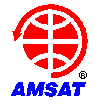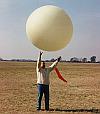


Language:
Español
Subjects:
Flight 2(bis)
Flight 3(bis)
Flight 4
Modules
Theory
Other 'ballooners'


The 'Globo' project started off as a collaboration between our local club (Club de Radioaficionados Lago San Roque, LU2HDX) and the Argentinian branch of AMSAT (AMSAT Argentina. LU7AA), in 1994, following the proposal by Mario Basavilbaso, LU3HEF, and John Coppens, ON6JC.
Later, I decided to present the project as a practical work to my students at the Universidad Católica de Córdoba, in the hope that this would stimulate their interest in real-world projects.
The first flight, without any experience, and almost no real
knowledge, failed at 15000m (45000ft), but gave us enough
information to correct our design for the next flights. This
first flight transmitted temperature, pressure, and humidity,
in an analog format, easily decodable with a simple interface. 
The second flight (really 2bis), reached correctly the planned 28000 meters (85000 ft)
height, and transmittedthe data in AX.25 type packet radio. It had also an analog repeater on board,
converting 80m SSB into 2m FM.

The third flight (also two intents) was launched on March 21th, 1995, and had a photographic camera, a telemetry transmitter with meteorological info, a several channels with internal parameters. The SSTV (Slow Scan Television) generator failed at the actual moment
of the launch.
At the moment, we're planning the payload for the fourth flight. Two principal goals here:
The launches were executed from Córdoba Airport, with the help from the staff of the Meteorological Office. Thanks to all of them, and to the data they provided to us to make a nice prediction of the impact point.
Each flight receives the help of many radioamateurs, in the whole of the country, and even from Uruguay, where signals were captured from the second and third flight. Without their help, it would have been impossible to obtain the complete flight data. The project would not make any sense without them.
Launch announcements, transmission formats, decoding programs, flight results, were distributed by the packet radio network, in the forma of a series of bulletins. These bulletins were kindly incorporated in the national AMSAT bulletins by José Plano, LU2FCY.